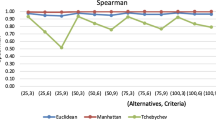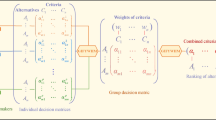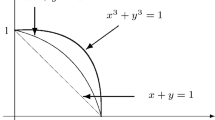Abstract
Decision making problems with fuzzy linguistic information and Choquet integral is investigated in this paper, to introduce three new aggregation operators: 2-tuple choquet integral averaging operator (TCIA), 2-tuple ordered choquet integral averaging operator (TOCIA) and combined 2-tuple choquet integral averaging operator which can be used to aggregate preference information that takes not only the form of linguistic variables but also study some of its desirable properties. Also, we developed a practical method based on TCIA as well as TOCIA operators for multiple attribute group decision making. Furthermore, in this approach alternative assessments are computed by the aggregation of 2-tuple linguistic information. Therefore, ranking alternatives or selecting the most desirable ones will be the outcome of the comparison between the 2-tuple linguistic information. Ultimately, the demonstration of the developed approaches, its practicality and its effectiveness is proved by a numerical example and a comparison with results issued from Wan method (Knowl-Based Syst 45:31–40, 2013).
Similar content being viewed by others
References
Beliakov G, James S, Mordelová J, Rückschlossová T, Yager RR (2010) Generalized Bonferroni mean operators in multi-criteria aggregation. Fuzzy Sets Syst 161(17):2227–2242
Bonissone PP, Decker KS (1986) Selecting uncertainty calculi and granularity: an experiment in trading-off precision and complexity. In: Kanal LH, Lemmer JF (eds) Uncertainty in artificial intelligence. North-Holland, Amsterdam
Bonferroni C (1950) Sulle medie multiple di potenze. Bollettino dell’Unione Matematica Italiana 5(3–4):267–270
Bordogna G, Fedrizzi M, Pasi G (1997) A linguistic modeling of consensus in group decision making based on OWA operators. IEEE Trans Syst Man Cybern Part: A Syst Hum 27:126–133
Cabrerizo FJ, Alonso S, Herrera-Viedma E (2009) A Consensus model for group decision making problems with unbalanced fuzzy linguistic information. Int J Inf Technol Decis Maki 8(1):109–131
Carlsson C, Fuller R (2000) Benchmarking and linguistic importance weighted aggregations. Fuzzy Sets Syst 114(1):35–42
Choquet G (1953) Theory of capacities. Annales de l’Institut Fourier 5:131–295
de Campos Martinez L, Jorge Bolanos M (1992) Characterization and comparison of Sugeno and Choquet integrals. Fuzzy Sets Syst 52:61–67
Degani R, Bortolan G (1988) The problem of linguistic approximation in clinical decision making. Int J Approx Reason 2(2):143–162
Delgado M, Verdegay JL, Vila MA (1993) On aggregation operations of linguistic labels. Int J Intell Syst 8(2):351–370
Estrella FJ, Espinilla M, Herrera F, Martínez L (2014) FLINTSTONES: a fuzzy linguistic decision tools enhancement suite based on the 2-tuple linguistic model and extensions. Inf Sci 280:152–170
Fan ZP, Feng B, Sun YH, Ou W (2009) Evaluating knowledge management capability of organizations: a fuzzy linguistic method. Expert Syst Appl 36(1):3346–3354
Feng B, Fan ZP, Suo WL (2009) A fuzzy linguistic method for evaluating collaboration satisfaction of NPD team using mutual-evaluation information. Int J Prod Econ 122(2):547–557
Grabisch M (1995) Fuzzy integrals in multicriteria decision making. Fuzzy Sets Syst 69:279–298
Grabisch M (1997) k-order additive discrete fuzzy measures and their representation. Fuzzy Sets Syst 92:167–189
Grabisch M, Nguyen HT, Walker EA (1995) Fundamentals of uncertainty calculi with applications to fuzzy inference. Kluwer Academics Publishers, Dordrecht
Harsanyi JC (1955) Cardinal welfare, individualistic ethics, and interpersonal comparisons of utility. J Polit Econ 63:309–321
Herrera F, Herrera-Viedma E (2000a) Linguistic decision analysis: steps for solving decision problems under linguistic information. Fuzzy Sets Syst 115:67–82
Herrera F, Herrera-Viedma E (2000b) Choice functions and mechanisms for linguistic preference relations. Eur J Oper Res 120:144–161
Herrera F, Martinez L (2000a) An approach for combining linguistic and numerical information based on 2-tuple fuzzy representation model in decision-making. Int J Uncertainty Fuzziness Knowl-Based Syst 8(5):539–562
Herrera F, Martinez L (2000b) A 2-tuple fuzzy linguistic representation model for computing with words. IEEE Trans Fuzzy Syst 8(6):746–752
Herrera F, Martinez L (2001a) A model based on linguistic 2-tuples for dealing with multigranularity hierarchical linguistic contexts in multiexpert decision-making. IEEE Trans Syst Man Cybern Part B: Cybern 31(2):227–234
Herrera F, Martinez L (2001b) The 2-tuple linguistic computational model. Advantages of its linguistic description, accuracy and consistency. Int J Uncertainty Fuzziness Knowl-Based Syst 9:33–48
Herrera F, Herrera-Viedma E, Alonso S, Chiclana F (2009) Computing with words and decision making. Fuzzy Optim Decis Mak 8:323–324
Herrera F, Herrera-Viedma E, Verdegay JL (1995) A sequential selection process in group decision making with a linguistic assessment approach. Inf Sci 85:223–239
Herrera F, Martinez L, Sanchez PJ (2005) Managing non-homogeneous information in group decision making. Eur J Oper Res 166:115–132
Jiang YP, Fan ZP, Ma J (2008) A method for group decision-making with multi-granularity linguistic assessment information. Inf Sci 178(4):1098–1109
Kacprzyk J (1986) Group decision making with a fuzzy linguistic majority. Fuzzy Sets Syst 18:105–118
Labreuche C, Mayag B, Duqueroie B (2015) Extension of the MACBETH approach to elicit an ordered weighted average operator. EURO J Decis Process. Springer, Berlin, Heidelberg
Marichal J-L (2002) Aggregation of interacting criteria by means of the discrete Choquet integral. In: Aggregation operators. Studies in fuzziness and soft computing, vol 97. Springer, Heidelberg, pp 224–244
Meng D, Pei Z (2013) On weighted unbalanced linguistic aggregation operators in group decision making. Inf Sci 223:31–41
Merigo JM, Casanovas M, Martínez L (2010) Linguistic aggregation operator for linguistic decision making based on the Dempster–Shafer theory of evidence. Int J Uncertainty Fuzziness Knowl-Based Syst 18(3):287–304
Morente-Molinera JA, Pérez IJ, Ureña MR, Herrera-Viedma E (2015a) Building and managing fuzzy ontologies with heterogeneous linguistic information. Knowl-Based Syst 88:154–164
Morente-Molinera JA, Pérez IJ, Ureña MR, Herrera-Viedma E (2015b) On multi-granular fuzzy linguistic modelling in group decision making problems: a systematic review and fut ure trends. Knowl-Based Syst 74:49–60
Murofushi T, Soneda S (1993) Techniques for reading fuzzy measures (lU): interaction index. In: 9th fuzzy system symposium, Sapporo, Japan, May 1993, pp 693–696 (in Japanese)
Parreiras RO, Ekel P Ya, Martini JSC, Palhares RM (2010) A flexible consensus scheme for multicriteria group decision making under linguistic assessments. Inf Sci 180(7):1075–1089
Park JH, Park EJ (2013) Genralized fuzzy benferroni harmonic mean operators and their applications in group decision making. J Appl Math 2013:604029
Park JH, Park JM, Kwun YC (2013) 2-Tuple linguistic harmonic operators and their applications in group decision making. Knowl-Based Syst 44:10–19
Shapley LS (1953) A value for n-person games. In: Kuhn HW, Tucker AW (eds) Contributions to the theory of games, vol. II. Annals of mathematics studies, vol 28. Princeton University Press, Princeton, pp 307–317
Subagadis YH, Schütze N, Grundmann J (2014) Multi-criteria multi-stakeholder decision analysis using a fuzzystochastic approach for hydrosystem management. In: Proceedings of ICWRS2014, Bologna, Italy, IAHS Publ. 364
Torra V (1996) Negation functions based semantics for ordered linguistic labels. Int J Intell Syst 11:975–988
Torra V (2002) Learning weights for the quasi-weighted means. Fuzzy Syst IEEE Trans Fuzzy Syst 10(5):653–666
Torra V (2011) Learning aggregation operators for preference modeling. In: Fürnkranz J, Hüllermeier E (eds) Preference learning. Springer, New York
Truck I (2015) Comparison and links between two 2-tuple linguistic models for decision making. Knowl-Based Syst 87:61–68
Wan SP (2013) 2-Tuple linguistic hybrid arithmetic aggregation operators and application to multi-attribute group decision making. Knowl-Based Syst 45:31–40
Wei GW (2009) Uncertain linguistic hybrid geometric mean operator and its application to group decision making under uncertain linguistic environment. Int J Uncertainty Fuzziness Knowl-Based Syst 17(2):251–267
Wei GW (2010) A method for multiple attribute group decision making based on the ET-WG and ET-OWG operators with 2-tuple linguistic information. Expert Syst Appl 37(12):7895–7900
Wei GW (2011) Some harmonic aggregation operators with 2-tupl linguistic assessment information and their application to multiple attribute group decision making. Int J Uncertainty Fuzziness Knowl-Based Syst 19(6):977–998
Wu J, Chiclana F, Herrera-Viedma E (2015) Trust based consensus model for social network in an incomplete linguistic information context. Appl Soft Comput 35:827–839
Xu ZS (2004a) A method based on linguistic aggregation operators for group decision making with linguistic preference relations. Inf Sci 166:19–30
Xu ZS (2004b) Uncertain linguistic aggregation operators based approach to multiple attribute group decision making under uncertain linguistic environment. Inf Sci 168:171–184
Yager RR (1988) On ordered weighted averaging aggregation operators in multicriteria decision making. IEEE Trans Syst Man Cybern 18:183–190
Yager RR (2009) On generalized Bonferroni mean operators for multi-criteria aggregation. Int J Approx Reason 50(8):1279–1286
Zadeh LA (1975a) The concept of a linguistic variable and its application to approximate reasoning-I. Inf Sci 8:199–249
Zadeh LA (1975b) The concept of a linguistic variable and its application to approximate reasoning-II. Inf Sci 8:301–357
Zadeh LA (1975c) The concept of a linguistic variable and its application to approximate reasoning-III. Inf Sci 9:43–80
Zadeh LA, Kacprzyk J (1999) Computing with words in information/intelligent systems—part 1: foundations; part 2: applications. Physica-Verlag, Heidelberg 1
Author information
Authors and Affiliations
Corresponding author
Rights and permissions
About this article
Cite this article
Sonia, H., Nesrin, H. & Chabouchoub, H. Development of some linguistic aggregation operators with conservation of interaction between criteria and their application in multiple attribute group decision problems. TOP 24, 635–664 (2016). https://doi.org/10.1007/s11750-016-0412-5
Received:
Accepted:
Published:
Issue Date:
DOI: https://doi.org/10.1007/s11750-016-0412-5




